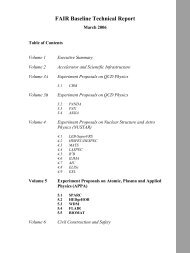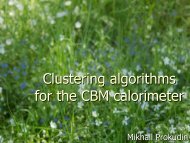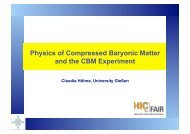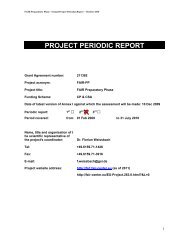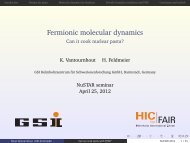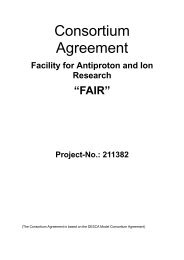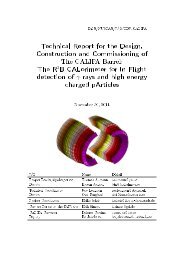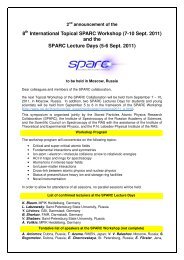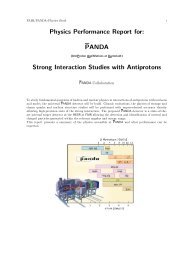NeuLAND - FAIR
NeuLAND - FAIR
NeuLAND - FAIR
You also want an ePaper? Increase the reach of your titles
YUMPU automatically turns print PDFs into web optimized ePapers that Google loves.
Apart from the excellent energy resolution of <strong>NeuLAND</strong>, the enhanced multi-neutron<br />
recognition capability with an efficiency of up to 60% for a reconstructed four-neutron<br />
event will constitute a major step forward.<br />
The presented design is the result of several years of R&D studies. Summaries of prototype<br />
tests and simulations are presented in chapters 3 and 4, respectively. Different<br />
design concepts have been followed, including converter-based solutions, e.g., a detector<br />
based on steel converter plus charged-particle detection with resistive-plate chambers<br />
(RPC). The RPC concept has been ruled out mainly because of its insufficient multineutron<br />
detection capability. A fully active detector with calorimetric properties has<br />
turned out to be the best solution. Submodules have been tested with proton and electron<br />
beams resulting in time resolutions of better than the required σt ≤ 150 ps, even<br />
with inexpensive photomultipliers. In accordance with simulations, improved timing<br />
properties have been obtained with optimized light guides.<br />
Extensive simulation studies have been performed leading to the final design. Different<br />
frameworks have been applied such as GEANT and FLUKA, leading to a remarkable<br />
agreement. The good accordance of simulations with available data leads to a consistent<br />
prediction of the neutron response for the detector. A fully-active detector design is<br />
required to provide the unambiguous identification of primary neutron interactions, the<br />
large efficiency at lower neutron energies and the high multi-neutron resolving power,<br />
the latter being due to its calorimetric properties. The effect of the granularity and<br />
the time resolution of the detector has been investigated in detail (section 4.3), leading<br />
to the most cost-effective solution presented here, which still meets the required design<br />
criteria. The final performance is demonstrated in section 4.5 for several physics cases.<br />
The details of the technical realization including mechanics, readout electronics, tests,<br />
calibrations, as well as the construction procedure are summarized in chapters 5 to 10.<br />
A detailed estimate of the investment cost for the construction is given in chapter 11.<br />
Several groups of the R 3 B collaboration will contribute to the construction of the Neu-<br />
LAND detector. The final assembly will take place at the GSI/<strong>FAIR</strong> site. We expect the<br />
beginning of construction in 2012, as soon as funding will be available. The construction<br />
of the full detector will take about 3.5 years, allowing for first experiments with the<br />
complete detector in 2016. An important milestone will be met by using a 20% detector<br />
for physics experiments in the end of 2014 in Cave C at GSI, which will already profit<br />
from an improved resolution for neutron detection.<br />
We consider the risk for technical difficulties in the production or for an insufficient<br />
performance of the detector to be negligible. The design based on fully-active scintillators<br />
with photomultiplier readout is rather robust and the simulations, on which our<br />
design decisions are based upon, have been verified against each other and experimental<br />
data. The fully-equipped detector – after full commissioning and first production runs<br />
in Cave C – will move to its final location in the R 3 B hall at the <strong>FAIR</strong> site in 2017,<br />
being fully operational for physics experiments in 2018 when Super-FRS will deliver first<br />
beams at <strong>FAIR</strong>.<br />
12





